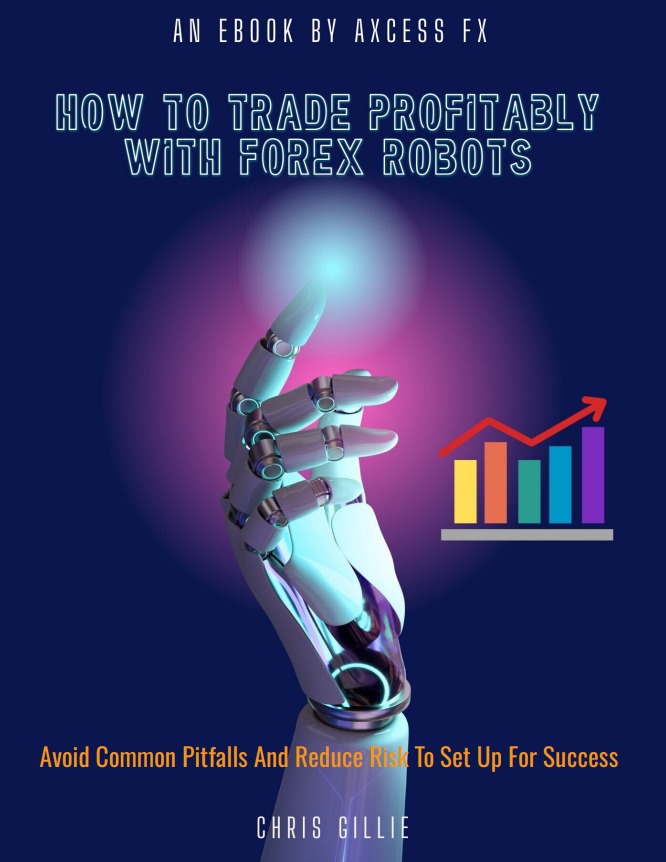Forex robots are intended to eliminate the emotional bias suffered by human traders, and to streamline trading processes for improved efficiency and profitability.
In reality though, trading Forex using automation tools like robots is not always straightforward. Traders can face unexpected challenges like software malfunction, unpredictable markets affecting algorithms, and strategy misalignment; all can lead to inconsistent performance and trading losses.
So what should you do if your Forex robot is consistently losing money? Well, to help you, this article will be broken down into three sections for an easier understanding: Section one is a broad introduction about robot trading losses and their impact. Section two will identify strategic responses and adjustments to losses, and section three will look at long term solutions and prevention.
Following this article you will know not only how to diagnose but also how to react quickly to adverse trading performance by your Forex robot. Read on to find out more.

Section 1: An Introduction To Robot Trading Losses and Its Impact On Traders
Have you ever wondered what are the most common reasons why Forex traders lose money using automated trading software and the psychological impact of these losses. We will cover these twin issues for you now.
What are the root causes of consistent Forex robot losses?
Consistent losses when trading with Forex robots can often be traced back to five factors, which are market volatility, strategy flaws, technical issues, over-reliance on back testing and a lack of customization. Lets look at each of these in turn:
Market Volatility: Forex markets are notoriously volatile and sudden market shifts can render the algorithm behind the robot’s trading strategy ineffective, leading to losses.
Strategy Flaws: If a Forex robot’s underlying strategy is flawed or outdated, it will likely under perform. Strategy flaws may include an inability to adapt to changing market conditions or poorly built-in automated risk management rules.
Technical Issues: Technical problems can include software bugs, glitches or inadequate algorithmic parameters that are impairing the trading robot’s functionality.
An over-reliance on back testing: Some robot developers will rely solely on historical data for strategy validation. Unfortunately, this can be misleading, as past performance is not always indicative of future results. Instead, proficient developers will also undertake thorough forward testing for improved strategy validation.
A lack of customization: A one-size-fits-all approach rarely works in the fast-paced Forex market. Forex robots with good customization capability will allow for greater adaption to changing markets, individual trader preferences and differing trading goals.
For a deeper understanding of the challenges of trading with automation, we have written a useful resource on common mistakes newbies make with Forex robots, which offers valuable insights and how to avoid common pitfalls.
The psychological impact of consistent losses
The psychological impact on a trader of consistent losses when using Forex robots should not be underestimated and can cause four undesirable psychological effects.

One of the most important is stress and anxiety as continuous losses can lead to high levels of these undesirable conditions which will impact on decision-making abilities. A loss of confidence is another psychological condition, as ongoing losses may see traders start doubting an underlying strategy and even their own decision-making skills.
Next, we have emotional trading. Also called revenge trading, in an attempt to recover losses, traders can make impulsive, emotion-driven decisions; unfortunately these actions can result in further losses. Finally, we have burnout, when the constant pressure and disappointment of loss making trades can lead to burnout, making it hard to re-engage effectively in trading.
To manage any of the above psychological impacts, consider the following:
a) Set realistic expectations: By understanding that losses are an integral part of Forex trading will allow for setting realistic expectations for robot performance.
b) Practice emotional discipline: Develop strategies to maintain emotional control and avoid impulsive decisions. We have written a dedicated article on staying emotionally balanced when trading Forex.
c) Take breaks: By taking regular breaks from trading can help manage stress and provide a fresh perspective. Regular breaks can vary from stepping away from a matter of minutes to even days depending on the level of stress being felt.

Section 2: Strategic Responses and Adjustments to Forex Robot Losses
Now that we have set the scene as to possible causes of losing money with Forex robots, now it is important to look at strategic responses and adjustments you can make when faced with a loss making Forex robot.
Immediate action and diagnosis to undertake when you notice consistent trading losses
When your Forex robot consistently loses money, immediate action is vital to prevent further losses to your capital account. You should consider all of the following actions as part of your diagnosis.
| Number | Action To Take |
|---|---|
| 1 | Consider an immediate pause in automated trading activities with the robot to prevent additional losses. |
| 2 | At a high level, review the robot’s settings and trading parameters to identify any obvious flaws or areas that need improvement. |
| 3 | Check for market changes to ensure that recent market conditions haven’t rendered your robot’s strategy ineffective and it still aligns with current market trends and adheres to your predetermined risk tolerance levels. Checks should include for over fitting which is the over reliance on historical data as the basis for creating a trading algorithm – So look to see the the robot’s strategy isn’t overly tailored to a narrow set of historical data, which may not be applicable in the current market. |
| 4 | Analyze the robot’s most recent trades in the trading log to see if you can quickly understand what went wrong. Your Forex robot’s trading history may help identify patterns common in your losing trades |
| 5 | Update the software, to make sure that your robot is running on the latest software version, as updates often fix known bugs and improve performance. |
| 6 | Seek expert analysis, as sometimes an external Forex expert’s perspective may identify issues that are not immediately obvious. |
| 7 | Undertake tests in different market conditions; back tests and forward tests in different market scenarios allow you to evaluate the robot’s adaptability. |
Adjusting your trading strategy
To improve your Forex robot’s performance, consider adjusting your trading strategy with a number of ways available to do this.
Reevaluate risk parameters
Consider tweaking the risk level settings on your Forex robot, especially if you are using out-of-the-box settings, as they may allow better alignment with your current trading goals and market conditions.

Modify trade criteria
Change the settings criteria on your Forex robot that trigger trade entries and exits. For example, an increase in market volatility may see the price move more than usual. In this case you could reduce the leverage settings on the robot to reduce the risk of a large move.
Incorporate different time frames
Consider using different time frames to enhance decision-making accuracy. Forex robots purchased from a reputable developer typically allow for setting different different time frame parameters.
Back test new strategies
Before going live, back test new strategies you have configured from adjusting parameter,s to ensure their effectiveness in different market scenarios.
Stay informed
If necessary, update your strategy based on any new market trends or economic events.
Technical tweaks and robot optimization
There are several technical adjustments available to optimize your Forex robot which we will highlight now:
- Adjust your trade frequency: Consider modifying how often the robot trades based on market volatility and performance.
- Optimize for current market conditions: Tailor the robot’s algorithms to better suit current market dynamics. The Forex market is fast moving and is susceptible to change.
- Improve trade execution speed: Enhance the robot’s ability to execute trades quickly to capitalize on rapid market movements. It may involve looking at reducing latency by diagnosing how the robot interacts with your online broker.
- Regular maintenance: Try and conduct regular check-ups and maintenance to ensure optimal performance.
- Utilize machine learning: Wherever possible, look to incorporate machine learning algorithms for continuous improvement based on past performance.

Seeking professional advice and community support
Engaging with Forex trading professionals and trading communities can provide a valuable source of support and a number of useful resources exist.
Consider joining online forums as active participation in online trading forums and Forex communities will deepen your experience and get you useful tips. From Discord and Telegram channels to Reddit forums are all good places to start.
Look to attend workshops, courses and webinars to learn from Forex experts. Such educational events can be attended either virtually or in a physical capacity.
Collaborating for solutions with other Forex traders to find ways to resolve common problems is another great way of using the power of the online community. Community discussions can also keep you informed of the latest Forex trading strategies and technological advances. Finally, think about consulting with a Forex trading expert as seeking advice from experienced Forex traders can help to gain new perspectives.

Risk management and diversification strategies
Take an honest look at your overall trading strategy. Do you have an effective risk management process? Are you sufficiently diversified? Both are key to mitigating losses and we think the following are the most important areas for consideration:
- Set stop-loss orders to limit potential losses on each Forex trade placement
- Spread your trades across different currency pairs or trading instruments.
- Employ money management techniques using strategies like position sizing to manage the amount of capital at risk.
- Regularly reassess your risk tolerance levels and adjust your Forex trading strategy accordingly.
- Consider hedging strategies to offset potential losses in your primary trading positions.
Section 3: Long-Term Solutions and Prevention in Forex Robot Trading
In this final section there are three areas to cover regarding long term solutions and loss prevention when trading with Forex robots. These are continuous learning, choosing the right robot at the start, and developing a resilient trading mindset.
Educating yourself through continuous learning in Forex trading
Continuous education is crucial in Forex trading as it is such a dynamic and fast moving market. You can educate yourself in a variety of ways which include:
Stay updated with Forex market trends by regularly following market news and developments to understand the factors influencing currency movements.
Read extensively by diving into books, articles, and research papers about Forex trading strategies and market analysis.
Practice with demo accounts, also known as paper trading, or forward testing to experiment with different Forex trading strategies without financial risk.
What to look for to choose the right Forex robot
Typically a Forex trader, unless technologically gifted enough to build their own automated trading tool, will need to purchase a Forex robot. Selecting the right robot from the word go involves assessing several key criteria:

- The performance track record: Look for robots with a proven track record of profitability and consistency which has been evidenced on respected performance verification sites like MyFXbook or FX Blue. It is not enough to accept performance figures directly from Forex robot websites without having these verified.
- Strategy compatibility: Ensure the robot’s trading strategy aligns with your trading style and goals. For example, are you a short term trader using swing trading or do you prefer trading infrequently taking longer term strategic positions?
- User reviews and feedback: Read reviews and feedback from other users to gauge a Forex robot’s reliability and effectiveness. A good place to start is a respected Forex software review site like FPA (Forex Peace Army).
- Customization options: Choose robots that offer customization options to tailor strategies to your needs. Important adjustable settings include time frames and position sizing.
- Customer support and updates: Opt for robots backed by strong customer support and regular software updates, again evidenced by reading the feedback of others.

For more information, we have written an in depth study on the criteria for selecting the best Forex robot.
Developing a resilient trading mindset
Building a resilient mindset is essential for long-term success in Forex trading. Firstly, you should accept losses as part of the process, understanding that they are inevitable and an integral part of trading. Maintaining emotional discipline is also vital. Try and cultivate the ability to keep emotions in check, avoiding impulsive decisions based on fear or greed. We have penned a detailed article on how to stay focused trading Forex.
A third way of developing a resilient trading mindset is to set realistic goals. By establishing achievable goals and measuring progress over time is better than focusing solely on short-term gains or losses.
Practicing patience and persistence is crucial and you must recognize that success in Forex trading often requires time and consistent effort, Finally, seek support when needed by seeking advice or support from more experienced traders or mentors.
We hope this article has been helpful. For another closely related resource, our lead contributor, Chris Gillie has written an E-Book, which you can find more about here, and explains “how to how to avoid common pitfalls and reduce risk when using Forex robots to set yourself up for success”

Written by Chris Gillie

Chris Gillie is the founder of Axcess FX, a Forex software review and research website. He is a former investment banker who worked in FX Sales on the UBS London trading floor. Chris has been using Forex trading software as part of his trading set-up since the late 2000s and the embryonic days of MetaTrader and the MQL coding language.
